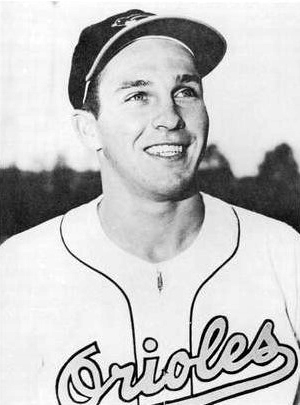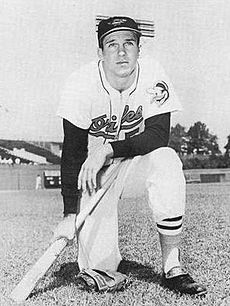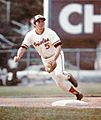Brooks Robinson facts for kids
Quick facts for kids Brooks Robinson |
|||
|---|---|---|---|

Robinson in 1959
|
|||
| Third baseman | |||
| Born: May 18, 1937 Little Rock, Arkansas, U.S. |
|||
| Died: September 26, 2023 (aged 86) Owings Mills, Maryland, U.S. |
|||
|
|||
| debut | |||
| September 17, 1955, for the Baltimore Orioles | |||
| Last appearance | |||
| August 13, 1977, for the Baltimore Orioles | |||
| MLB statistics | |||
| Batting average | .267 | ||
| Hits | 2,848 | ||
| Home runs | 268 | ||
| Runs batted in | 1,357 | ||
| Teams | |||
|
|||
| Career highlights and awards | |||
|
|||
| Induction | 1983 | ||
| Vote | 91.98% (first ballot) | ||
Brooks Calbert Robinson Jr. (May 18, 1937 – September 26, 2023) was an American third baseman in Major League Baseball. He played his entire career for the Baltimore Orioles from 1955 to 1977. People called him "the Human Vacuum Cleaner" or "Mr. Hoover" because he was so good at catching baseballs. Many consider him the best defensive third baseman ever.
Brooks Robinson was an All-Star 18 times. He won 16 Gold Glove Awards in a row, which is a record for a position player. He played 2,870 games at third base, more than anyone else in history. He also spent 23 seasons with just one team, the Baltimore Orioles. This was a major league record for a long time.
He joined the Orioles as a teenager in 1955. He became a key player as the team became one of the best. Between 1965 and 1974, the Orioles won four American League (AL) championships and two World Series titles. In 1964, he was named the AL Most Valuable Player (MVP). That year, he had a .317 batting average, 28 home runs, and led the AL with 118 runs batted in (RBIs).
In the 1970 World Series, Robinson's amazing defensive plays made him famous. He stopped many hits from the Cincinnati Reds players. He also drove in runs in the first four games. His great performance earned him the World Series MVP Award. The Orioles won the Series in five games.
Brooks Robinson was elected to the Baseball Hall of Fame in 1983. He was chosen in his first year of eligibility. After he stopped playing, he worked as a broadcaster for the Orioles. He was also known for being very kind and patient with fans.
Contents
Early Life and Baseball Dreams
Brooks Calbert Robinson was born on May 18, 1937, in Little Rock, Arkansas. His father played semi-pro baseball and taught young Brooks the game. Brooks Jr. loved baseball and rooted for the St. Louis Cardinals. His favorite player was Stan Musial.
In high school, Brooks played American Legion Baseball. His team was very good. He also played basketball and was offered a scholarship to the University of Arkansas. But Brooks wanted to be a professional baseball player.
In 1955, three major league teams wanted to sign him. The New York Giants, the Cincinnati Redlegs, and the Baltimore Orioles. Brooks chose the Orioles because they showed the most interest. They also offered young players a chance to play in the big leagues.
Playing for the Baltimore Orioles
Starting His Career (1955–1959)
Brooks Robinson played his first professional game on June 3, 1955. He joined the Orioles on September 17, 1955. In his first game, he got two hits and drove in a run. He later said that major league pitchers made him look like a "young, green, immature eighteen-year-old."
In 1956, he spent most of the year in the minor leagues. He hurt his knee while sliding but recovered. He showed amazing fielding skills even at a young age. In 1957, he competed for the third base job. He got another knee injury but returned to play. He hit his first major league home run that year.
By 1958, his defense was very impressive. Orioles manager Paul Richards said, "I think Brooks is in a class by himself as a defensive third baseman." He helped Hoyt Wilhelm throw a no-hitter by making three great plays. In 1959, he had another injury scare but recovered. His time in the minor leagues helped his hitting.
Becoming an MVP (1960–1965)
By 1960, Brooks was the Orioles' main third baseman. He was chosen for his first of 18 straight All-Star Games. On July 15, he became the first Oriole to hit for the cycle. This means he hit a single, double, triple, and home run in one game. The Orioles were close to winning the AL championship that year. Brooks batted .294 with 14 home runs. He finished third in the AL MVP voting and won his first Gold Glove Award.
In 1961, he played every game of the season. He continued to build his reputation as a great defender. In 1962, he had another strong year. He hit two grand slams in a row, which was very rare. He batted over .300 for the first time (.303) and hit 23 home runs. Sports Illustrated called him "the best third baseman in the league."
In 1964, Brooks practiced his hitting and used a heavier bat. He made an amazing play against the Yankees, diving to stop a ball and throwing the runner out while still on the ground. He had a fantastic end to the season, batting .464 with 28 RBIs in September. He won the AL MVP Award, hitting .317 with 28 home runs and leading the league with 118 RBIs. In 1965, he batted .297 and led the Orioles in batting average and RBIs.
World Series Champion (1966–1971)
First World Series Win (1966)
Before the 1966 season, the Orioles got Frank Robinson, another great player. Brooks had 70 RBIs by mid-season. In the All-Star Game, he made several great defensive plays and had three hits. He was named the game's MVP. The Orioles won the AL championship for the first time with Brooks. He batted .269 with 23 home runs and 100 RBIs.
In the 1966 World Series against the Los Angeles Dodgers, Frank and Brooks hit back-to-back home runs in Game 1. The Orioles won that game. In Game 4, Brooks made a fantastic double play that helped the Orioles keep their lead. The Orioles swept the Dodgers in four games, winning their first World Series championship. A famous picture shows Brooks jumping to celebrate with his pitcher after the win.
Defensive Masterpiece (1970)
In 1967, Brooks hit a home run in the All-Star Game. He played all 162 games in 1968. In 1969, the Orioles won their division and went to the World Series against the New York Mets. Brooks made an amazing barehanded catch in Game 1. He made another great play in Game 2. In Game 4, he hit a ball that was caught by Ron Swoboda in an amazing diving catch. The Orioles lost the series in five games.
Brooks had a strong year in 1970. He hit his 200th home run and got his 2,000th hit. He also broke the AL record for most games played at third base. The Orioles won their division again.
In the ALCS, Brooks batted .583 as the Orioles swept the Twins. This sent them to the World Series against the Cincinnati Reds. In Game 1, Brooks made an incredible backhanded play at third base. He then hit a solo home run that won the game for Baltimore.
Brooks continued his amazing defense throughout the Series. He made diving catches and quick throws. Reds manager Sparky Anderson joked, "I'm beginning to see Brooks in my sleep. If I dropped this paper plate, he'd pick it up on one hop and throw me out at first." Brooks batted .429 with two home runs in the Series. His defensive plays were so outstanding that he won the World Series MVP Award.
Another Strong Season (1971)
Before the 1971 season, Brooks signed a big contract. He played 50 games without making an error. He received the most votes for AL players in the All-Star Game. He broke Eddie Mathews' record for most games played at third base. He batted .272 with 20 home runs and 92 RBIs.
The Orioles won their division for the third year in a row. In the ALCS, Brooks hit a home run and batted .364. The Orioles swept the Athletics and went to the World Series against the Pittsburgh Pirates. Brooks had three RBIs in Game 2 and made another diving catch. In Game 6, he hit a sacrifice fly that scored the winning run. But the Pirates won the series in seven games.
Later Years and Retirement (1972–1977)
In 1972, Brooks batted .250. He won the Roberto Clemente Award, which honors players who represent baseball well. In 1973, he made the All-Star Game again. He broke Pie Traynor's record for most hits by a third baseman. He also started two triple plays. He got his 2,500th hit that year. The Orioles returned to the playoffs but lost to the Athletics.
In 1974, Brooks had a good batting average of .288. This was his best average since 1965. The Orioles won their division again but lost to the Athletics in the playoffs. In 1975, he struggled with a sore thumb. His batting average was low, and he missed the All-Star Game.
In 1976, a younger player named Doug DeCinces started playing third base more often. Brooks' playing time became less frequent. In 1977, his final season, he had a memorable moment. On April 19, he hit a walkoff home run in the 10th inning to win a game for the Orioles.
Brooks Robinson announced his retirement on August 21, 1977. He received a standing ovation from fans. A month later, the Orioles held a special ceremony to honor him.
Career Highlights
Brooks Robinson played 23 seasons, all with the Baltimore Orioles. He batted .267 with 2,848 hits, 268 home runs, and 1,357 RBIs. In 39 postseason games, he batted .303 with 5 home runs and 22 RBIs.
He set an AL record by leading the league in fielding percentage 11 times. His career fielding percentage of .971 was the highest for any third baseman when he retired. He holds major league records for most games played at third base (2,870). He also has records for most putouts (2,697), assists (6,205), total chances (9,165), and double plays (618) at third base.
Brooks Robinson was an All-Star 18 times and played in the World Series four times.
| Category | G | BA | AB | R | H | 2B | 3B | HR | RBI | SB | CS | BB | SO | OBP | SLG | OPS | PO | A | DP | E | FLD% |
|---|---|---|---|---|---|---|---|---|---|---|---|---|---|---|---|---|---|---|---|---|---|
| Total | 2,896 | .267 | 10,654 | 1,232 | 2,848 | 482 | 68 | 268 | 1,357 | 28 | 22 | 860 | 990 | .322 | .401 | .723 | 2,712 | 6,205 | 621 | 264 | .971 |
Player Style and Personality
Brooks Robinson was known for his unique style at the plate. He used a custom-made batting helmet with a shorter bill. He would cut it himself to avoid distractions. He wasn't a fast runner, but he always ran hard.
His amazing defensive skills earned him nicknames like "Human Vacuum Cleaner." He was always moving at third base, which was unusual for players at the time. He had quick hands and released the ball very fast. Teammate Chuck Estrada said Brooks had "great hands, a quick release, and the runner was always out."
Many baseball experts agree that Brooks Robinson was the greatest third baseman ever. Jim Murray of The Los Angeles Times wrote that future third basemen would be measured by Brooks. He won 16 Gold Glove awards, which is tied for the second most by any player.
Brooks was very particular about his glove. He would take a year to prepare a new glove before using it in games. He also liked to try different bats, even those of his teammates.
Beyond his playing, Brooks was loved by fans for his kindness. He was patient and interested in them. An Orioles broadcaster said that when Brooks signed autographs, he would ask fans about their families and lives. He truly cared about the people who supported him.
Life After Baseball
After retiring as a player, Brooks Robinson became a color commentator for the Orioles' TV broadcasts. He traveled with the team and called many games. He continued this role until 1993.
In 1982, Brooks helped start the Major League Baseball Players Alumni Association. This group helps retired players and promotes baseball. He became its president later on.
In 2005, Brooks became a part-owner of Opening Day Partners. This group owns several minor league baseball teams. He helped create the York Revolution team in York, Pennsylvania, where he had played minor league baseball. The team's stadium is located at 5 Brooks Robinson Way, named in his honor. Brooks also helped raise money to restore a baseball field in his hometown of Little Rock.
In 2015, Brooks auctioned off many items from his career. This included his 1970 Gold Glove and his 1966 World Series ring. The auction raised money for his charitable foundation.
Honors and Recognition
 |
|
| Brooks Robinson's number 5 was retired by the Baltimore Orioles in 1978. |
The Orioles retired Brooks Robinson's jersey number (5) on April 14, 1978. In 1983, he was elected to the Baseball Hall of Fame in his first year of eligibility. He was one of only 16 players to be chosen on the first try. He and Frank Robinson were the first members of the Baltimore Orioles Hall of Fame in 1977.
In 1999, The Sporting News ranked Brooks Robinson as one of the 100 Greatest Baseball Players. He was also chosen for the Major League Baseball All-Century Team. Fans voted him onto the Rawlings Gold Glove Award#All-time Gold Glove Team in 2008. In 2015, he was named one of the Orioles Franchise Four, recognizing the four greatest living players in Orioles history.
Brooks Robinson also received awards outside of baseball. He won the Golden Plate Award in 1984. A road in Pikesville, Maryland, was renamed Brooks Robinson Drive in his honor.
Three statues of Brooks Robinson have been created. The first was placed in York, Pennsylvania, in 2008. The second was unveiled in downtown Baltimore in 2011. This statue shows him throwing out a runner at first base. A larger bronze sculpture was unveiled at Oriole Park at Camden Yards in 2012.
Personal Life
Brooks Robinson met his wife, Constance Louise "Connie" Butcher, on an Orioles team flight in 1959. She was a flight attendant. They married on October 8, 1960, and lived in Owings Mills, Maryland. They had four children: Brooks David, Chris, Michael, and Diana.
One of Brooks' favorite hobbies was reading. He enjoyed books about history, especially the Civil War and World War II. He also liked country western music.
Health and Passing
Brooks Robinson faced some health issues later in his life. He had successful surgery for prostate cancer in 2009. In 2010 and 2011, he had more surgeries and dealt with infections. In 2012, he had an accident where his chair fell from a stage, leading to another hospital stay.
Brooks Robinson passed away from heart disease at his home in Owings Mills, Maryland on September 26, 2023, at the age of 86.
Images for kids
See also
 In Spanish: Brooks Robinson para niños
In Spanish: Brooks Robinson para niños
- List of Major League Baseball career home run leaders
- List of Major League Baseball career hits leaders
- List of Major League Baseball career doubles leaders
- List of Major League Baseball career runs scored leaders
- List of Major League Baseball career runs batted in leaders
- List of Major League Baseball career total bases leaders
- List of Major League Baseball players to hit for the cycle
- List of Major League Baseball annual runs batted in leaders
- List of Major League Baseball players who spent their entire career with one franchise





